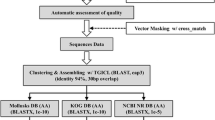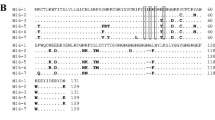Abstract
The pearl oyster, Pinctada martensii, is the primary species used for the aquaculture production of marine pearls in China and Japan. Genetic tools and resources are needed to study the genome of this species and to understand the molecular basis of development, growth, host defense, pearl formation, and other important traits. In this study, we developed a set of expressed sequence tags (ESTs) for P. martensii. We constructed cDNA libraries from adult tissues and sequenced 7,128 ESTs. Clustering analysis identified 788 contigs (covering 5,769 ESTs) and 1,351 singletons, yielding a total of 2,139 unique genes. Of these unique genes, only 935 had significant (E-value ≤ 0.005) hits in GenBank, and the remaining 1,204 (56.3%) were novel. Most of the known genes are related to cellular structure, protein binding, and metabolic processes. Putative host-defense genes (86) were identified including C-type lectin, ferritin, polyubiquitin, proteases, protease inhibitors, scavenger receptors, heat shock proteins, and RAS oncogenes. The EST sequences developed in this study provide a valuable resource for future efforts on gene identification, marker development, and studies on molecular mechanism of host defense in pearl oysters.

Similar content being viewed by others
References
Arason GJ (1996) Lectins as defense molecules in vertebrates and invertebrates. Fish Shellfish Immunol 6:277–289
Ashburner M, Ball CA, Blake JA, Botstein D, Butler H, Cherry JM, Davis AP, Dolinski K, Dwight SS, Eppig JT, Harris MA, Hill DP, Issel-Tarver L, Kasarskis A, Lewis S, Matese JC, Richardson JE, Ringwald M, Rubin GM, Sherlock G (2000) Gene ontology: tool for the unification of biology. The Gene Ontology Consortium. Nat Genet 25(1):25–29
Deugnier Y, Turlin B, Loreal O (1998) Iron and neoplasia. J Hepatol 28(Suppl 1):21–25
Doumas S, Kolokotronis A, Stefanopoulos P (2005) Anti-inflammatory and antimicrobial roles of secretory leukocyte protease inhibitor. Infect Immun 73:1271–1274
Ewart K, Johnson S (2001) Lectins of the innate immune system and their relevance to fish health. J Mar Sci 58:380–385
Gauthier JD, Vasta GR (1994) Inhibition of in vitro replication of the oyster parasite Perkinsus marinus by the natural iron chelators transferrin, lactoferrin, and desferrioxamine. Dev Comp Immunol 18(4):277–286
Greaves DR, Gordon S (2005) Recent insights into the biology of macrophage scavenger receptors. J Lipid Res 46:11–20
Gueguen Y, Cadoret JP, Flament D, Barreau-Roumiguiere C, Girardot AL, Garnier J, Hoareau A, Bachere E, Escoubas JM (2003) Immune gene discovery by expressed sequence tags generated from hemocytes of the bacteria-challenged oyster, Crassostrea gigas. Gene 303:139–145
Guo X, Ford SE, Zhang F (1999) Molluscan aquaculture in China. J Shellfish Res 18:19–31
Hamilton G, Colbert JD, Schuettelkopf AW, Watts C (2008) Cystatin F is a cathepsin C-directed protease inhibitor regulated by proteolysis. EMBO J 27(3):499–508
Hann HW, Stahlhut MW, Hann CL (1990) Effect of iron and desferoxamine on cell growth and in vitro ferritin synthesis in human hepatoma cell lines. Hepatology 11:566–569
Hiemstra PS (2000) Novel roles of protease inhibitors in infection and inflammation. Biochem Soc Trans 30:116–120
Hooper NM (2002) Proteases in biology and medicine. Portland, London
Hu W, Yan Q, Shen DK, Liu F, Zhu ZD, Song HD, Xu XR, Wang ZJ, Rong YP, Zeng LC, Wu J, Zhang X, Wang JJ, Xu XN, Wang SY, Fu G, Zhang XL, Wang ZQ, Brindley PJ, McManus DP, Xue CL, Feng Z, Chen Z, Han ZG (2003) Evolutionary and biomedical implication of a Schistosoma japonicum complementary DNA resource. Nat Genet 35:139–147
Jenny MJ, Ringwood AH, Lacy ER, Lewitus AJ, Kempton JW, Gross PS, Warr GW, Chapman RW (2002) Potential indicators of stress response identified by expressed sequence tag analysis of hemocytes and embryos from the American oyster, Crassostrea virginica. Mar Biotechnol 4:81–93
Liu XF, Theil EC (2005) Ferritin as an iron concentrator and chelator target. Ann N Y Acad Sci 1054(1):136–140
Matsubara K, Okubo K (1993) Identification of new genes by systematic analysis of cDNAs and database expression. Curr Opin Biotechnol 4(6):672–677
Peatman EJ, Wei X, Feng J, Liu L, Kucuktas H, Li P, He C, Rouse D, Walladce R, Dunham R, Liu Z (2004) Development of expressed sequence tags from eastern oyster (Crassostrea virginica): lessons learned from previous efforts. Mar Biotechnol 6:S491–S496
Quilang J, Wang SL, Li P, Abernathy J, Peatman E, Wang YP, Wang LL, Shi YH, Wallace R, Guo XM, Liu ZJ (2007) Generation and analysis of ESTs from the eastern oyster. Crassostrea virginica Gmelin and identification of microsatellite and SNP markers. BMC Genomics 8:157
Roberts SB, Goetz FW (2003) Expressed sequence tag analysis of genes expressed in the bay scallop, Argopecten irradians. Biol Bull 205:227–228
Santoro MG (2000) Heat shock factors and the control of the stress response. Biochem Pharmacol 59(1):55–63
Shi YH, Wang AM, Wu X (2004) Survey on polychaete infestation of farmed pearl oyster, Pinctada martensii in China. Marine Sciences 28(7):13–18, In Chinese
Shi YH, Wang Y, Hong K, Hou ZH, Wang AM, Guo XM (2009) Characterization of 31 EST-derived microsatellite markers for the pearl oyster Pinctada martensii (Dunker). Mol Ecol Resour 9(1):177–179
Song L, Xu W, Li C, Li H, Wu L, Xiang J, Guo X (2006) Development of expressed sequence tags from the bay scallop, Argopecten irradians irradians. Mar Biotechnol 4(6):161–169
Tanguy A, Guo X, Ford SE (2004) Discovery of genes expressed in response to Perkinsus marinus challenge in eastern (Crassostrea virginica) and Pacific (C. gigas) oysters. Gene 338:121–131
Vizcaino JA, Gonzalez FJ, Suarez MB, Redondo J, Heinrich J, Delgado-Jarana J, Hermosa R, Gutierrez S, Monte E, Llobell A, Rey M (2006) Generation, annotation and analysis of ESTs from Trichoderma harzianum CECT 2413. BMC Genomics 7:193
Wang Y, Guo X (2006) Development and characterization of EST-SSR markers in the eastern oyster Crassostrea virginica. J Shellfish Res 25(2):790
Yang RY, Hsu DK, Liu FT (1996) Expression of galectin-3 modulates T cell growth and apoptosis. Proc Natl Acad Sci USA 193(13):6737–6742
Zhang L (2002) The development of international pearl industry and the countermeasures taken by China to speed up Chinese pearl industry. Marine Science 26(11):10–13, In Chinese
Acknowledgments
This study was funded by the National High Technology Research and Development Program of China (863 Program, 2006AA10A409), the National Basic Research Program of China (973 Program, 2009CB126005, 2010CB126405), and the National Science Foundation of China (30640440657 and 30460105), and Guo’s participation is supported by the Ministry of Science and Technology’s program for International Science and Technology Cooperation (2004DFA07200).
Author information
Authors and Affiliations
Corresponding authors
Rights and permissions
About this article
Cite this article
Wang, A., Wang, Y., Gu, Z. et al. Development of Expressed Sequence Tags from the Pearl Oyster, Pinctada martensii Dunker. Mar Biotechnol 13, 275–283 (2011). https://doi.org/10.1007/s10126-010-9296-9
Received:
Accepted:
Published:
Issue Date:
DOI: https://doi.org/10.1007/s10126-010-9296-9




